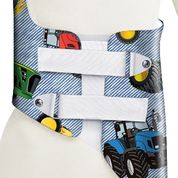
As if puberty wasn’t hard enough, children diagnosed with Scoliosis often experience worsening symptoms in the growth spurts that occur before or during this time. In a time of increased hormones and social awareness, wearing a brace to school can become a trigger for anxiety and lead to resistance to wearing a brace.
We’ve compiled several different strategies that parents looking to support their children during this time have found beneficial.
1.) Brace Image
Begin by talking to your doctor to understand the full scope of possible long-term impacts of your child going without their brace during school hours. This will inform your decisions going forward, and will help your child understand specifically how a brace will help, diminishing its image as a mere hindrance. Assure your child that these braces largely go unnoticed and can help prevent or decrease the likelihood of needing surgery in the future. You can also make it more fun by adding color to the brace so your child feels better about the treatment.
2.) Social Media
It is important to normalize wearing the brace while also listening to and acknowledging your child’s concerns. The rise of social media has provided a platform for those with Scoliosis to tell their story. Showing your child these individuals as well as the widespread support they garner can help decrease the stigma.
3.) Talking With Your Child’s Teachers and Parents of Classmates
Another way to ensure a smooth transition is by reaching out to teachers and parents of your child’s classmates. One bad experience in the classroom could make your child even more hesitant to wearing the brace in the future. Other parents can be helpful in educating their children so that yours will feel more comfortable. This can be combined with another popular method of creating a timeline paired with a reward system to encourage your child to wear the brace daily.

4.) Night Time Braces Are Available
If wearing the brace to school is still a topic of controversy, it is worth it to check with your doctor if a nighttime brace could be an alternative option. Daytime braces usually require a minimum of 16 hours of wear time with a minimum corrective value of 50%. Nighttime braces have been shown to have significantly higher corrective values in shorter periods of time.
The Providence Night Time Brace is a popular choice and is often prescribed for younger patients in times of peak growth. Nighttime braces can offer 98% corrective value in just 12 hours, and will likely be a more popular choice for most children. However, these are primarily used for patients under the age of 10 who still have significant growth periods left.
Some doctors may approve wearing a day brace on a limited schedule that omits school time. These schedules commonly run from 2:00 PM to 6:00 AM and then break for classes.
** Disclaimer on Scoliosis Braces : Before making any changes to your child’s routine, please consult a medical professional for more information on whether switching to a night brace is a viable choice. This information has been compiled from parents who have experience with children with scoliosis, but is not intended to provide medical advice. Each case should be treated individually by a medical professional to ensure the best possible results.
